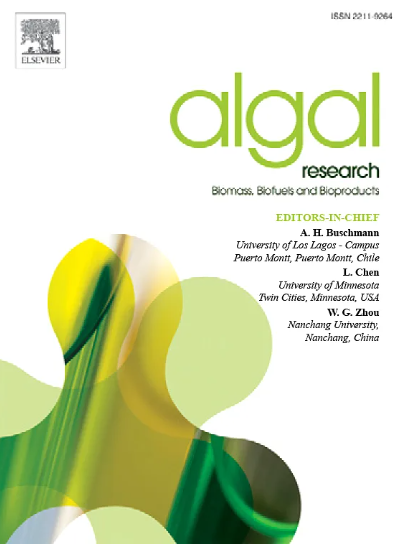氮限制和碳源对核核小球藻产氢和产脂的影响
IF 4.5
2区 生物学
Q1 BIOTECHNOLOGY & APPLIED MICROBIOLOGY
Algal Research-Biomass Biofuels and Bioproducts
Pub Date : 2025-06-03
DOI:10.1016/j.algal.2025.104128
引用次数: 0
摘要
从绿藻中提取生物燃料(包括氢气和脂质)是一种有吸引力的可再生能源生产方式。在氮限制条件下,核核小球藻同时产生H2和脂质。本研究考察了氮碳源对pyrenoidosa生长及H2和脂质共生的影响,探讨了光合电子传递、NADPH生成和乙酰辅酶a代谢等调控机制。在5%氮浓度(0.35 mM NH4Cl)处理下,总脂含量为干重的45.0%,H2产量最高(241.42 mL L−1)。氮素限制降低了PSII活性,抑制了光合作用下O2的进化,从而为增强H2生成创造了有利的厌氧条件。光合电子传递链中的多余能量促使氢化酶作为终端电子受体消耗多余的电子并产生H2。此外,氮限制诱导PSII受体侧过度还原,导致NADPH积累,为脂肪酸合成提供还原能力。醋酸的添加促进了C. pyrenoidosa的生长、H2生成和脂质积累,推荐浓度为2 mL L−1。提出醋酸抑制光合作用,从而降低光合O2的进化。此外,乙酸转化为乙酰辅酶a,为脂肪酸合成提供前体,并促进NADH的生成,为脂肪酸合成和H₂生成提供了所需的还原力。上述结果突出了限氮和醋酸对提高小球藻产氢和产脂的积极作用,为通过人工调控提高小球藻的产能效率提供了依据。本文章由计算机程序翻译,如有差异,请以英文原文为准。
Effect of nitrogen limitation and carbon sources on hydrogen and lipid production by Chlorella pyrenoidosa
Biofuel (including H2 and lipids) from green algae is an attractive way to produce renewable energy. Under nitrogen-limitation, Chlorella pyrenoidosa produced both H2 and lipids. In this study, the effects of nitrogen and carbon sources on the growth and the co-production of H2 and lipids in C. pyrenoidosa were examined, and the regulatory mechanisms including photosynthetic electron transport, NADPH production and acetyl-CoA metabolism were investigated. The peak H2 yield (241.42 mL L−1) was found in 5 % nitrogen concentration (0.35 mM NH4Cl) treatment, with the total lipid content being 45.0 % of dry weight. Nitrogen-limitation decreased PSII activity, inhibiting photosynthetic O2 evolution, and thereby creating favorable anaerobic conditions for enhanced H2 production. Excess energy in the photosynthetic electron transport chain prompted hydrogenase to consume surplus electrons as the terminal electron acceptor and produce H2. Furthermore, nitrogen-limitation induced overreduction on the PSII acceptor side, resulting in the accumulation of NADPH, which provided reducing power for fatty acids synthesis. The addition of acetic acid enhanced the growth, H2 production, and lipid accumulation in C. pyrenoidosa, with a recommended concentration of 2 mL L−1. It was proposed that acetic acid inhibited photosynthesis, subsequently decreasing photosynthetic O2 evolution. Additionally, acetic acid was converted into acetyl-CoA to provide the precursor for fatty acid synthesis, and it also promoted the generation of NADH, which provided the reducing power required for both fatty acid synthesis and H₂ production. These results highlight the positive roles of nitrogen limitation and acetic acid in enhancing H2 and lipid production in C. pyrenoidosa and provide a basis for improving Chlorella's energy production efficiency through artificial regulation.
求助全文
通过发布文献求助,成功后即可免费获取论文全文。
去求助
来源期刊

Algal Research-Biomass Biofuels and Bioproducts
BIOTECHNOLOGY & APPLIED MICROBIOLOGY-
CiteScore
9.40
自引率
7.80%
发文量
332
期刊介绍:
Algal Research is an international phycology journal covering all areas of emerging technologies in algae biology, biomass production, cultivation, harvesting, extraction, bioproducts, biorefinery, engineering, and econometrics. Algae is defined to include cyanobacteria, microalgae, and protists and symbionts of interest in biotechnology. The journal publishes original research and reviews for the following scope: algal biology, including but not exclusive to: phylogeny, biodiversity, molecular traits, metabolic regulation, and genetic engineering, algal cultivation, e.g. phototrophic systems, heterotrophic systems, and mixotrophic systems, algal harvesting and extraction systems, biotechnology to convert algal biomass and components into biofuels and bioproducts, e.g., nutraceuticals, pharmaceuticals, animal feed, plastics, etc. algal products and their economic assessment
 求助内容:
求助内容: 应助结果提醒方式:
应助结果提醒方式:


